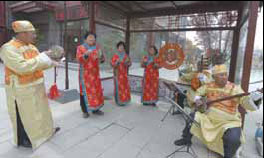
A performance in the style of the Song Dynasty (960-1279) is held in Qingzhou, a satellite city of Weifang. Ju Chuanjiang / China Daily
Authorities of the ancient city of Weifang said its cultural industry will be the centerpiewce of its new initiative to develop an environmentally friendly economy.
"The city is endowed with a rich heritage, including its time-honored tradition of producing and flying kites, which spells huge potential for Weifang's cultural industry," said Chu Baojie, head of Weifang Department of Publicity.
The history of settlement in Weifang dates back more than 7,000 years. Previous generations have left numerous cultural legacies, including more than 1,800 cultural relics, ancient ruins, buildings and inscriptions.
Traditional folk arts like kites and woodcarving have stood the test of time and continue to play a key role in the city's economy in the 21st century, according to the local government.
Local authorities want to pass down and rejuvenate the ancient cultures by developing a modern cultural industry around them.
Chu said there are various financial incentives in place for promoting the cultural sectors, including a 7-million-yuan fund for building cultural facilities in rural areas, a 2-million-yuan fund for research and developing kites and a 3-million-yuan fund for literary and artistic creation.
He noted that the cultural industry will help improve the economy and quality of life.
Because of the government's emphasis on the industry, more than 4,000 culture-related enterprises have settled in Weifang, and their combined capital totals more than 40 billion yuan.
The revenues from these enterprises reached 19.45 billion yuan last year, accounting for 4.85 percent of local GDP.
Currently there are 208 cultural projects under construction, covering such fields as painting, animation, film and video making and software development.
Weifang has 46 industrial parks to accommodate culture enterprises. Four of the parks are recognized as national demonstration zones, and nine are demonstration zones at the provincial level.
To date, 1,350 enterprises have settled in the parks, creating job opportunities for 24,300 people.
These include the 15-billion-yuan Yunmen Mountains Eco-Friendly Creativity Park in Qingzhou, a satellite city of Weifang. This is a site for film and video production, tourism, performances and expositions.
More than 10 events are held each year in Weifang to encourage cultural exchanges and product trading.
The China Weifang Expo on Cultural and Artistic Products, which concluded on April 25, attracted more than 1,000 artists from China and abroad to showcase their works. Transactions at the event totaled 930 million yuan.
In the rural areas, public facilities are being built and updated to foster an atmosphere of culture.
To date, more than 460,000 square meters of facilities, including culture stations and bookstores, have been built, and another 400,000 sq m are under construction.
When finished, all townships in Weifang will have culture stations and all villages will have bookstores.
Last year, there were 2,000 performances in the rural areas, 68,000 film tickets and 400,000 books were distributed.
The city has opened all its art centers, libraries and culture stations to the public for free.
